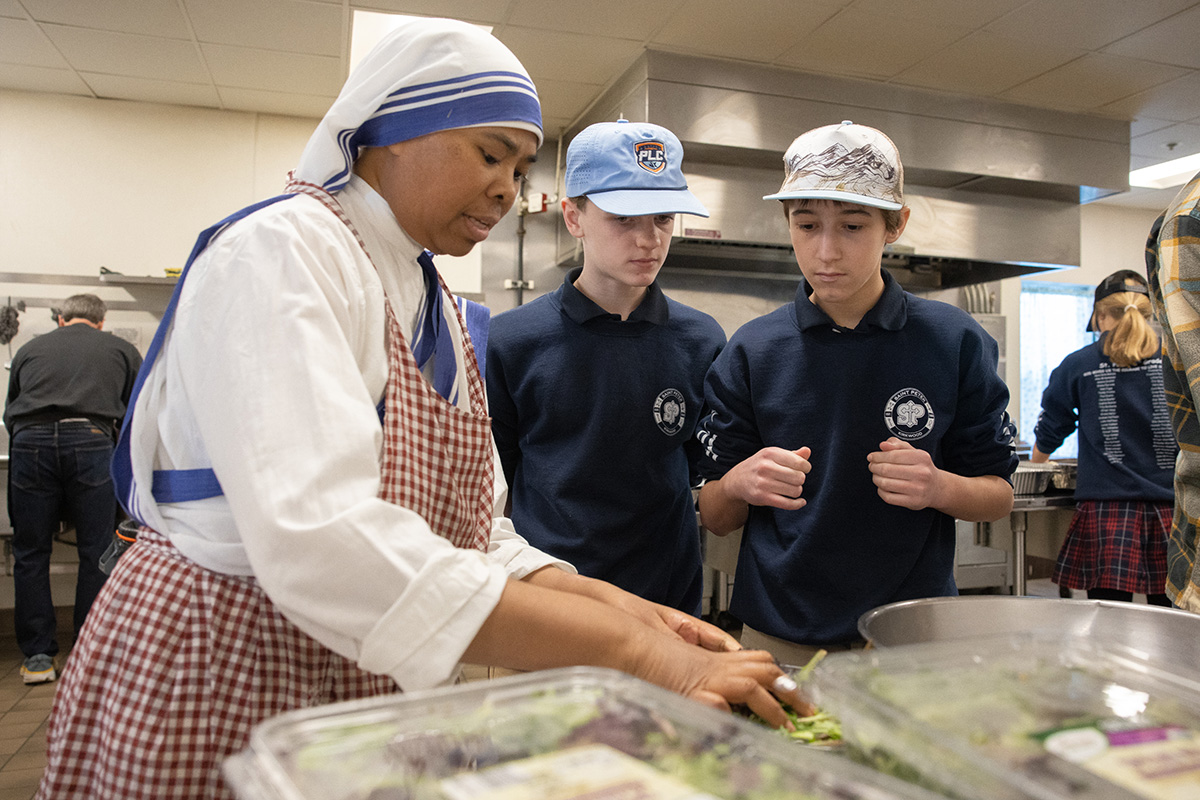St. Ambrose School ‘buries the alleluia,’ burns palms into ashes in preparation for Lent


A white banner bearing the world “alleluia” hung on the ambo at the 8 a.m. Mass on Feb. 28 at St. Ambrose Parish and School. Half an hour later, the banner — and symbolically, the word itself — was in the ground, not to return until Easter.
“The Church during the season of Lent does not use ‘alleluia’ during those 40 days, until Easter Sunday when it is sung magnificently in all our churches,” said Father Jack Siefert, pastor of St. Ambrose.
After Mass, students and teachers gathered outside in the parish’s Our Lady of Fatima courtyard to participate in “burying the alleluia” and burning palms to prepare for the start of the Lenten season on Ash Wednesday. Father Siefert placed bundles of palms, distributed on Palm Sunday last year, into a small fire pit and lit them ablaze. The ashes were sifted and mixed with oil before being blessed and distributed at the parish’s Ash Wednesday Masses.
“It’s always been a tradition of the Church that anything blessed can never be thrown away — it has to be burned or buried,” Father Siefert explained. “(Blessed palms) need dignity and respect. So we burn them as a way to show that, and then we use them for something good. The goodness of the gift of palms moves forward to become ashes for the next year.”
While the ashes burned, Father Siefert took the alleluia banner, rolled up inside a tube and wrapped in a plastic bag to keep it dry, and buried it behind the statue of Our Lady of Fatima. The word alleluia means “God be praised,” and the banner will be unearthed during Holy Week in preparation for the joyful return of the alleluia on Easter.
“Burying that alleluia calls us to remember that it is a time of penance,” Father Siefert said. “To refrain from using that word inspires us through that symbolic burial just to focus on God, so that when we do

celebrate Easter Sunday and we say that word again for the first time in a long time, it has that much more meaning because we’ve been through a desert experience.”
This is the first year that the school has participated in a palm burning and burying of the alleluia.
“It’s a visual reminder of the season we’re getting ready to begin,” St. Ambrose principal Michele Grellner said. “I think it prepares (the students) for the journey of the next 40 days. We buried the alleluia in a little tomb — we put it away, we’re not going to see it. And then on Easter, we’re going to resurrect it, so we’re going to see what resurrection means.”
During Lent, students at St. Ambrose also pray the Stations of the Cross every week, and classes create paper chains from strips of paper with their personal Lenten practices — typically something they’re giving up — written on them. When the students receive their ashes on Ash Wednesday, they’ll be able to remember where the ashes came from and why they’re important.
The use of ashes is found as far back as the Old Testament, where dressing in sackcloth and ashes was a form of repentance, mourning and humility. The ashes marked in the shape of a cross on the foreheads of the faithful on Ash Wednesday are a reminder of our own need to repent and grow closer to the Lord throughout the Lenten season.
Father Jack Siefert buried an “alleluia” banner behind a statue of Our Lady of Fatima Feb. 28 at St. Ambrose Church in St. Louis.Photo Credits: Jacob Wiegand A white banner … St. Ambrose School ‘buries the alleluia,’ burns palms into ashes in preparation for Lent
Subscribe to Read All St. Louis Review Stories
All readers receive 5 stories to read free per month. After that, readers will need to be logged in.
If you are currently receive the St. Louis Review at your home or office, please send your name and address (and subscriber id if you know it) to subscriptions@stlouisreview.com to get your login information.
If you are not currently a subscriber to the St. Louis Review, please contact subscriptions@stlouisreview.com for information on how to subscribe.







